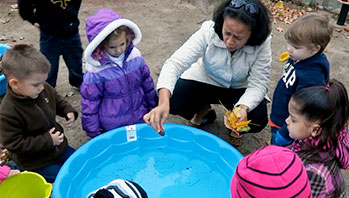- clipboard
- other nonfiction books about animals and the sounds they make
- paper
- pen
- recording device
- wildlife video or CD with sound (optional)
- listen
- loud
- pitch
- sound
- source
- volume
MA Standards:
Speaking and Listening/SL.PK.MA.3: Ask and answer questions in order to seek help, get information, or clarify something that is not understood.
Language/L.PK.MA.6: Use words and phrases acquired through conversations, listening to books read aloud, activities, and play.
MA Draft STE Standards:
Life Sciences/From Molecules to Organisms/LS1/3.C: Use their sense in their exploration and play to gather information. [Structure and Function]
Head Start Outcomes:
Approaches to Learning/Initiative and Curiosity: Asks questions and seeks new information.
Logic and Reasoning/Reasoning and Problem Solving: Recognizes cause and effect relationships.
Logic and Reasoning/Reasoning and Problem Solving: Classifies, compares, and contrasts objects, events, and experiences.
Science Knowledge/Conceptual Knowledge of Natural and Physical Worlds: Observes, describes, and discusses living things and natural processes.
PreK Learning Guidelines:
English Language Arts/Language 2: Participate actively in discussions, listen to the ideas of others, and ask and answer relevant questions.
Science and Technology/Inquiry Skills 1: Ask and seek out answers to questions about objects and events with the assistance of interested adults.
Science and Technology/Life Sciences 10: Observe and identify the characteristics and needs of living things: humans, animals, and plants.
Science and Technology/Living Things and Their Environment 15: Use their senses of sight, hearing, touch, smell, and taste to explore their environment using sensory vocabulary.
Explore Together (outdoors): Listening Walk: Animal Sounds

© Commonwealth of Massachusetts, Department of Early Education and Care. All rights reserved.
Stem Key Concepts: Sounds have a source; A sound can be tracked to its source; Different objects make different sounds; Sounds vary in three ways: volume, pitch, and timbre
ELA Focus Skills: Speaking and Listening, Vocabulary
Educator Prep: Explore an outside area that you know has wildlife that children can hear. If such an area is not available, use a video of animals, birds, and fish with audio so children can hear the sounds the animals make. If using a video, adjust the activity accordingly.
Safety Tips:
- Be aware of and check areas for poison ivy, poison sumac, nettles and bushes with thorns before taking children outside.
- What kinds of animal sounds do you think we will hear outside?
- Where do you think we will hear animal sounds?
Once outside, encourage children to use the new sound vocabulary they have been learning as they explore and discuss the sounds. Ask questions such as,
- How do you think you can find where that chirping sound is coming from?
- How do you know the source of the sound is nearby? Can you describe the sound?
Then ask children to interpret the sounds in terms of pitch and volume. For example, if children hear a bird, ask questions such as:
- Can you describe the sound the bird is making? How is it different from the sound of the (dog barking/sound we heard on the video)?
- How would you describe the pitch of the bird’s sounds? Do you notice any patterns in the bird sounds?
You may want to record the animal sounds.
Reflect and Share
Once inside, play back the sounds children heard and have them share what they learned about the sound. Then ask children what they think the sounds might mean. For example, say,
- Joe, you said the bird made a high chirp-chirp sound. Why do you think the bird was chirping? Why do you make sounds?
- I wonder if birds use high sounds and low sounds to communicate different things to other birds.
Then have children document their observations by dictating, writing, or drawing the sounds they heard.
